One reason business owners and entrepreneurs love modern-day marketing is because it’s so measurable.
Just 20 or 30 years ago, the best way to reach your target audience was through ads on TV or radio. You had to run them repeatedly and hope people called your hotline, visited your stores, or bought whatever you sold.
Today, you can tell right away which ads do well on social media, which blog posts bring in the most traffic and which emails have the best open rates.
Traditionally, this is what the sales funnel is all about — a simplified representation of a customer’s journey as they move through the stages of awareness, consideration, and decision-making.
However, marketers soon realized that many leads (or even sales) seemingly come out of nowhere. And this is where the concept of the dark funnel comes into play.
The dark funnel is used to describe touchpoints outside the typical sales funnel (both online and offline) where buyers engage, research, and make decisions but aren’t immediately accounted for by attribution or tracking software.
Because many of these touchpoints aren’t measured or tracked by CRMs, companies tend to overlook them. Yet these channels that make up the dark funnel are where buyers research and discover your products or services.
Why the Dark Funnel is Such a Big Deal Right Now
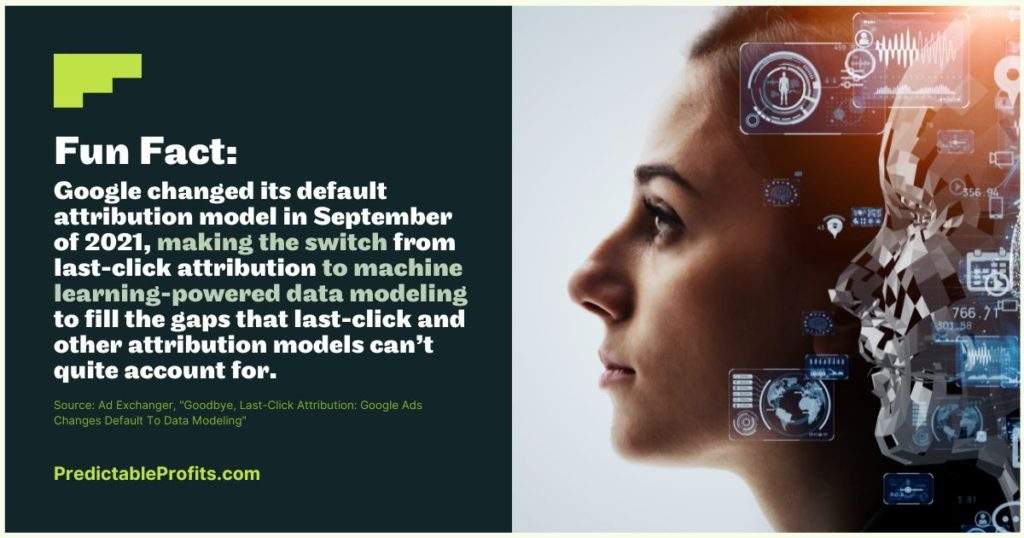
These days, there’s been an abrupt change in how buyers make decisions — a disruption, if you will — compared to how they made buying decisions 10-15 years ago.
If you did B2B sales or marketing back in 2010 or so, you know that big industry conferences or trade shows were a huge deal.The latest software, newest tech, or hottest product or service would be at these events.
You might search for information online but sales reps often completed the purchasing process.
These days, however, we’re in a different landscape.
- Buyers have become online researchers.
- B2B buyers are hyper-connected. They talk, interact, and engage with peers via social media channels and other online communities.
- People gather information now from an assortment of channels, including through word-of-mouth, podcasts, YouTube, newsletters, and events.
This means the new buyer’s journey is now more complex, with many more touchpoints along the way.
Furthermore, sales teams nowadays just can’t rely on the old way of closing deals. Nor can marketers just focus on the typical sales funnel and its stages to understand their buyers’ journey.
Instead, they must consider all the channels that make up the dark funnel.
As more buyers today have become researchers., the more they encounter you during the buyer’s journey of awareness, interest, consideration, and taking action, the better your chances of converting them.
Read more about it here: “[LIVE Sessions] Demand Generation: How to Fill Your Sales Pipeline (in 2022).”
Which Channels Make Up The Dark Funnel?
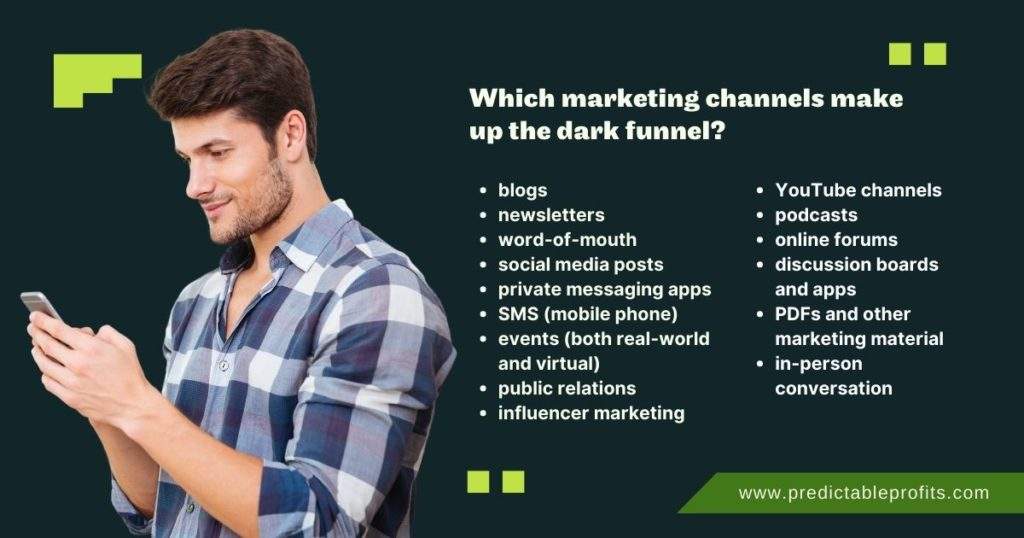
Your CRM’s usual channels — channels that can be tracked and monitored — include organic search traffic, social media, direct traffic, paid social and paid search ads, email marketing, and referrals.
Channels your CRM can’t track make up the many touchpoints in the dark funnel. These include:
Blogs and Newsletters
These are two of the most common dark funnel touchpoints. Buyers often sign up for a company’s blog or newsletter long before they’re ready to make a purchase.
Word-of-Mouth
Word-of-mouth is one of the most powerful dark funnel touchpoints. This is because people are more likely to trust recommendations from friends and family than marketing messages from companies.
Social Media
Social media platforms such as Twitter, LinkedIn, and Facebook are excellent places to find potential leads. Many companies use social media to generate awareness and interest in their products or services.
Your market spends lots of time on social media, so dark social might be considered the largest subset of the dark funnel. According to Statista, the most-used dark social media channels in the U.S. and UK are:
- Private messaging apps
- Posts on social media accounts
- Word-of-mouth offline/in-person
- SMS (mobile phone)
Note that dark funnel activities on social media also include brand reviews and “quiet” consumption (i.e., people who view your content without liking, commenting, or sharing)
Events
These include interaction within both real-world events (such as traditional sales conferences and industry trade shows) and virtual events (such as webinars, online seminars, and similar networking events).
Events are great ways to reach potential leads. They allow companies to showcase products or services and build relationships with potential customers.
Public Relations
Public relations can be a great way to generate brand awareness. This is especially true when you can secure placements in high-profile publications.
Common dark funnel touchpoints for public relations include:
- Media mentions
- Press releases
- Article placements
- Guest appearances on news outlets, talk shows, podcasts, and YouTube channels
- Influencer marketing
Referral programs
A referral program is a great way to get potential leads from current customers. Happy customers who have a stellar experience with your product or service will likely refer others to you.
Podcasts and YouTube Channels
Podcasts and YouTube channels are two other great dark funnel touchpoints. Many people use these platforms to consume information.
And just like with blogs and newsletters, potential leads often subscribe to a company’s podcast or YouTube channel long before they make a purchase.
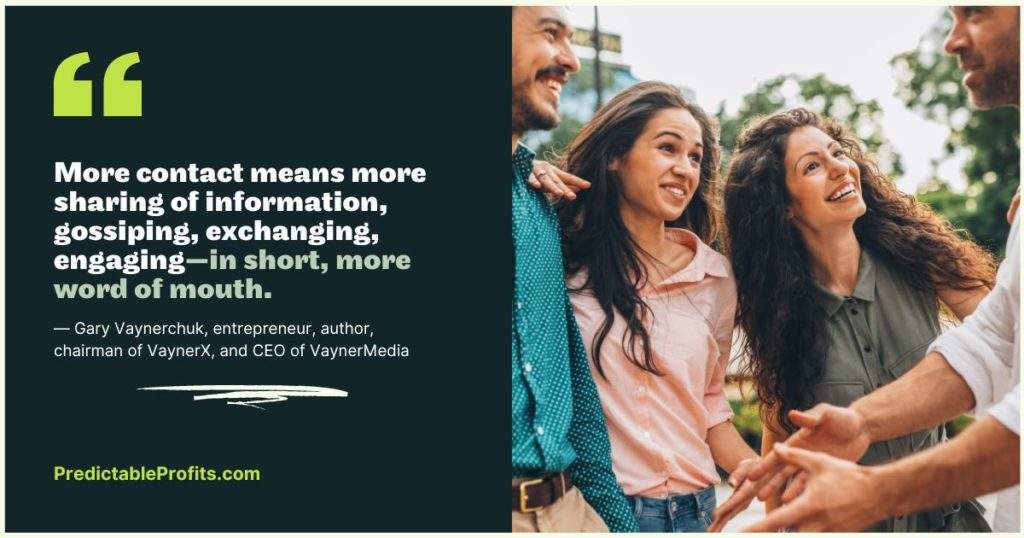
What’s important to remember about the dark funnel is that it’s not just made up of online channels.
Offline channels such as print ads, radio, and TV can be just as effective.
Gaining media attention and becoming an expert source for journalists are fantastic ways to position yourself as a leading authority in your industry. By becoming a leading authority, you can increase your fees, enhance your credibility, and have customers actively seek you out.
More about it here: “3 Ways To Get Media Attention For Your Business.”
The Dark Funnel vs. Dark Social — Are They the Same?
The dark funnel refers to untrackable channels and touchpoints your buyers use to discover, research, and evaluate what you offer. Dark social refers to this subset of activities on just social media.
In this case, dark social covers everything from tags and likes to comments, views, and shares. Conversations on the platforms and their various messaging applications are also included.
Understand that much of what visitors do in dark social blends back into the rest of the dark funnel.
Think about visitors who see your LinkedIn post or watch your YouTube video but later search for your website organically or revisit unread emails from you with renewed interest.

Speaking of social media, here are a couple of other related pieces you might want to check out:
What the Dark Funnel Means Now for Your Marketing Efforts
In B2B marketing, the typical company’s strategy centers around acquiring customer contact information. This is so sales reps have people to contact.
Many companies still use this approach — nurturing leads down a funnel.
With the dark funnel, you now can move people through your buying process at scale.
Keep in mind that, according to Forrester, we’re seeing major shifts in B2B buying behavior. The three biggest developments are:
- The word “buyers” now means a buying group.
- The number of buying interactions jumped by 10 (from 17 to 27).
- Buyers go everywhere for information.
Because people have access to all the information they need now, they can make buying decisions without talking to sales.
This is how marketing is done today.
As such, you must create content that reaches your target audience at all stages of their buying journey.
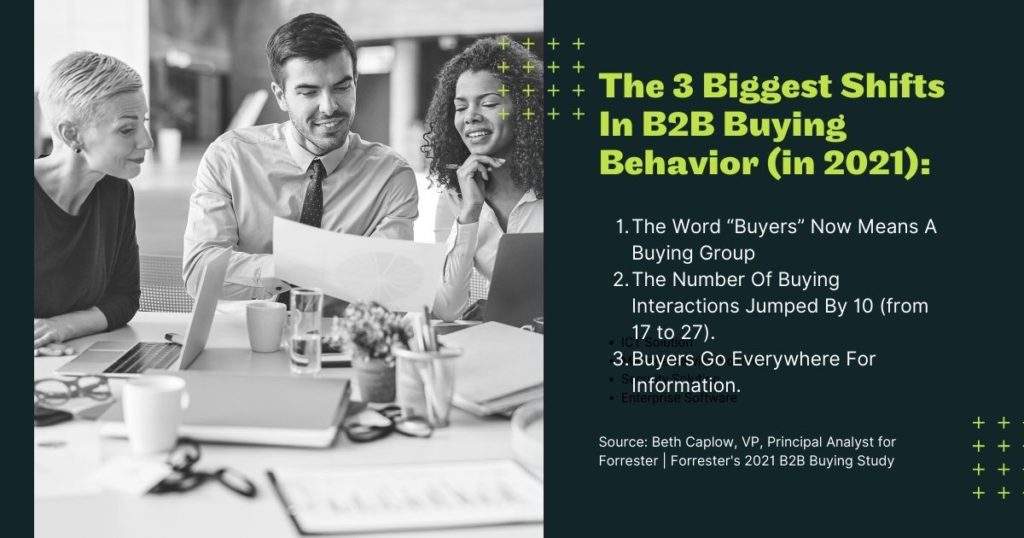
Here’s a tip: not every message you send to a potential client needs to have a sales pitch. This is especially true at the beginning when the client has no idea who you are or what you offer.
Read more about it here: “How To Create Effective Marketing Communication That Converts.”
Steps You Should Take to Market Your Company Today (With the Dark Funnel in Mind)
1. First, you must ensure you take into account all the touchpoints along the buyer’s journey. This means going beyond just the typical sales funnel and attribution tracking.
2. Look for content gaps at each stage and create high-quality content to fill them.
3. Focus on creating a stellar customer experience at every touchpoint. This includes your website, social media presence, regular blog posts, podcasts, and events.
4. Use the right mix of marketing channels to reach potential leads at each stage of the buyer’s journey, including:
- A combination of paid and organic efforts on search and social.
- Both inbound and outbound marketing efforts.
- A mix of online and on-ground marketing channels.
Setting suitable objectives and identifying strategies or opportunities are vital to growing a business. Nevertheless, you must turn your ideas into actions to achieve your end goals. Read about tactical planning in this related piece.

Implementing omnichannel marketing is essential for business success these days.
Every time you have an outstanding customer experience while shopping from a brand or interacting with that brand, there’s a strong chance that marketers implemented a successful omnichannel approach.
More about that here: “Omnichannel Marketing: What It is and Why You Should Use It.”
The B2B Buyer's Journey Through the Dark Funnel
Here’s an example of how a buyer might navigate from awareness to consideration to decision-making before choosing your brand:
- A potential customer saw one of your posts on Linkedin while scrolling through his feed.
- Meanwhile, another co-worker saw the same post but was sufficiently impressed by the new insight that he mentioned it in a work discussion.
- A week passed, and this potential customer of yours continues to hear about you from an influencer on Instagram.
- He attends a webinar a couple of weeks later, where the presenters cite your brand as a source. Your customer bookmarks the notes for review later.
- Ads start showing up on Facebook. He sees them but doesn’t click on them.
- A few days later, while working on something else completely, he noticed your brand mentioned again in a discussion on discord.
- The following week, his team lead shares a PDF resource he downloaded (which you created) and shares it with the entire team via Slack.
- On his way home, he listens to your podcast– which he picked up from the literature he got earlier that day.
- That Monday, he looks you up on Google, clicks on your website and reads your blog posts, and subscribes to your newsletter.
- A problem comes up at work, but now he knows how to get things done– and schedules a strategy call with your sales team to take that next step.
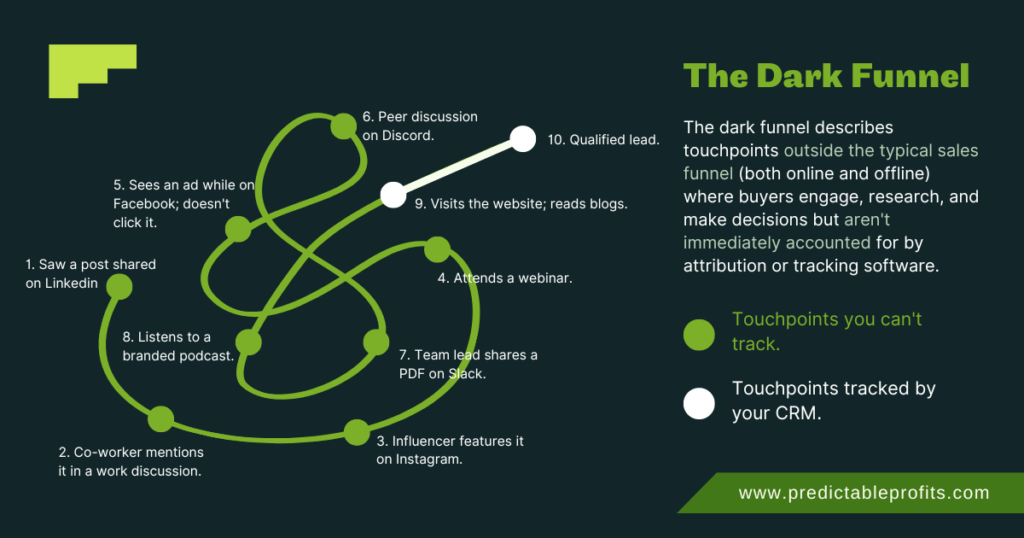
See now how a customer journey like this hardly conforms to a traditional sales funnel?
Your data might show this particular buyer’s journey began with a Google search. But the reality is, this buyer was interested even as far back as your speaking engagement from several weeks ago.
The content from all those touchpoints further reinforced interest. But, according to your CMS, those channels didn’t get credit for closing the sale.
Just as marketing within the dark funnel has become more important these days, a deeper understanding of demand generation is also necessary.
Read more about it here: “Demand Generation vs. Lead Generation: What’s the Difference?”
A Final Word About the Dark Funnel (and Your Ongoing Marketing Efforts)
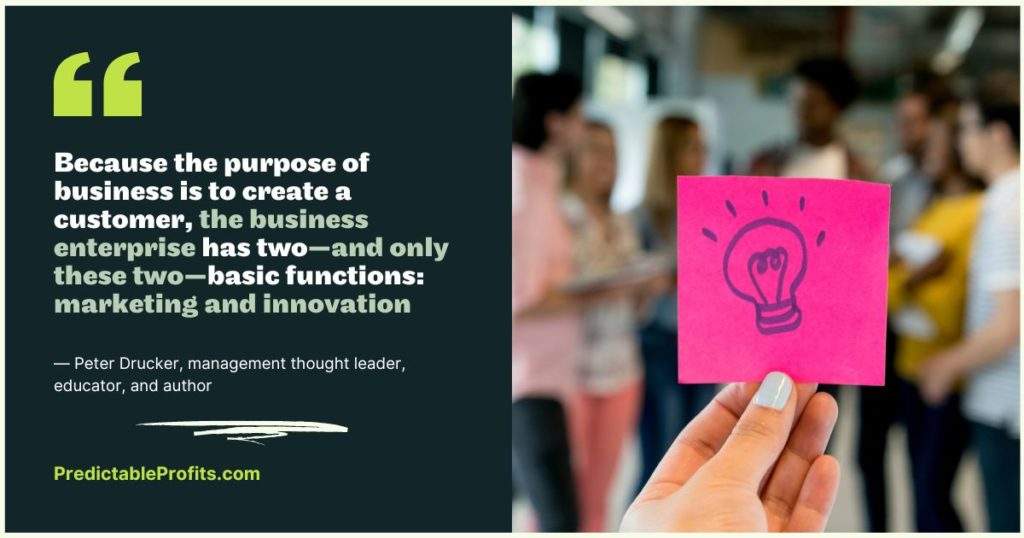
The point is, the dark funnel exists. And it is often a missed opportunity for marketers and business owners.
Touchpoints within the dark funnel are often misrepresented in sales data and analytics, but this doesn’t mean your marketing efforts are in vain. Your leads just might not be ready to buy when they first encounter your brand.
The dark funnel allows you to nurture them and is just one more reason why an effective content marketing strategy is so important for B2B companies.
So keep producing great content, focus on delivering an amazing customer experience, and use the right channels to reach potential leads at each stage of their journey. Do all these things well, and you’ll see results — even if your sales data doesn’t reflect it.
Be part of our ever-growing community of seven- and eight-figure business owners:
- Check us out on the Predictable Profits YouTube channel.
- Connect with us on Linkedin.
- Join other entrepreneurs (like yourself) on our Facebook page.
- And if you haven’t already, sign up for our daily business coaching video series (by entering your email address below).

